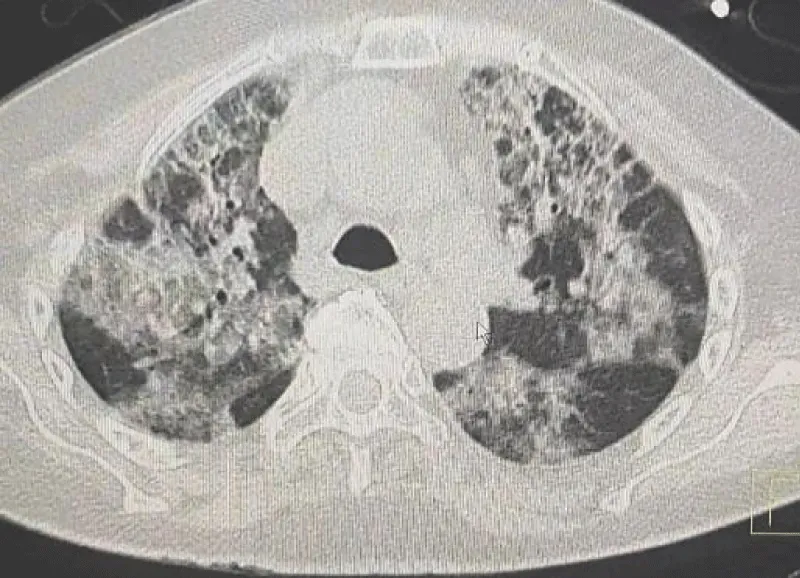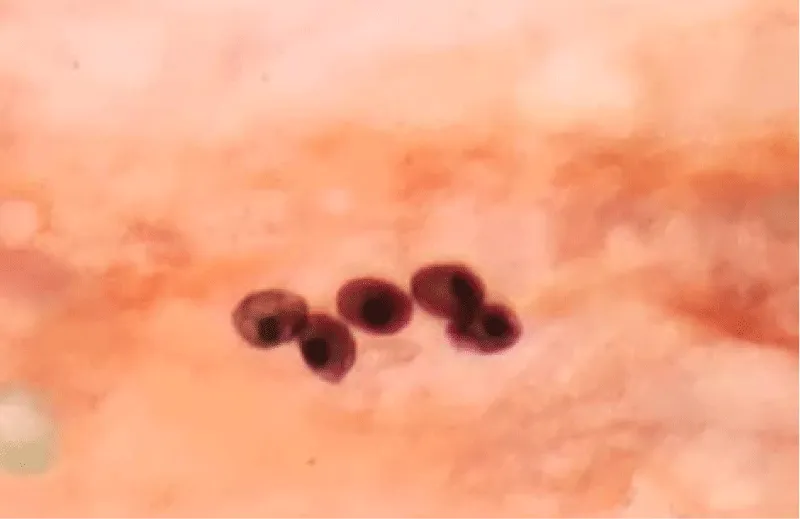Archives of Preventive Medicine
Pneumocystis jirovecii pneumonia in rheumatologic disease: A case report indicating possible need of prophylaxis
Tejas Bende1*, Yogya Jha2, Sushrut Ganpule3, Geethu Joe4 and Rajeev Soman5
2Consultant Physician, Department of General Medicine, Jupiter Hospital, Pune, India
3Consultant Pulmonologist, Department of Pulmonology, Jupiter Hospital, Pune, India
4Consultant Microbiologist, Department of Microbiology, Jupiter Hospital, Pune, India
5HOD & Consultant ID Physician, Department of Infectious Diseases, Jupiter Hospital, Pune, India
Cite this as
Bende T, Jha Y, Ganpule S, Joe G, Soman R (2023) Pneumocystis jirovecii pneumonia in rheumatologic disease: A case report indicating possible need of prophylaxis. Arch Prev Med 8(1): 020-022. DOI: 10.17352/apm.000033Copyright
© 2023 Bende T, et al. This is an open-access article distributed under the terms of the Creative Commons Attribution License, which permits unrestricted use, distribution, and reproduction in any medium, provided the original author and source are credited.An 81-year-old female with Granulomatosis and polyangiitis on immunosuppression with methotrexate, steroids, and Rituximab but not on prophylaxis, developed findings of Pneumocystis jirovecii pneumonia (PJP). She was treated with an alternative regimen, clindamycin and primaquine along with caspofungin and corticosteroids. Secondary prophylaxis with cotrimoxazole was initiated after completion of treatment. This case highlights the importance of early diagnosis, treatment difficulties, and the need for prophylaxis for HIV-negative patients on immunosuppressive treatment.
Introduction
Pneumocystis jirovecii Pneumonia (PJP) is a life-threatening opportunistic fungal infection. It occurs mainly in immunocompromised hosts, such as HIV-positive patients, and patients on corticosteroids, chemotherapy, and other immunosuppressive therapy. We report a case of PJP in a patient with Granulomatosis with Polyangiitis (GPA) on immunosuppressive treatment and highlight the need for prophylaxis for PJP.
Case history
An 81 year old female presented to Jupiter Hospital on 5/10/2023 with fever, cough, and shortness of breath for 2 weeks. She was a known case of GPA on treatment with methotrexate initially 25 mg per week which was modified to 10 mg per week 6 months prior and prednisolone 5 mg per day. She had also received Rituximab 2 doses in 2021 and was not on prophylaxis with cotrimoxazole.
On presentation, the patient had respiratory distress, tachypnea, and hypoxia (PO2 -36 mmHg), which required ICU admission and non-invasive ventilation. Hemoglobin was 8.4 gm/dl, WBC 2870/µL, serum LDH 357 and BDG was elevated at 360pg/ml. Anemia and leukopenia were probably due to long-term methotrexate use. The patient’s HIV status was negative.
Chest x-ray showed bilateral infiltrates which had increased compared to radiographs 2 weeks earlier. High-resolution Computed Tomography (CT) thorax revealed ground glass opacities and fibrotic changes (Image 1). The latter could be due to treated GPA. Although classical CT findings of PJP such as extensive ground glass opacities with peripheral and basal sparing were absent, there was high suspicion considering the clinical presentation and the immunosuppressed status. Bronchoscopy and BAL fluid GMS stain showed a ‘crushed ping pong ball’ appearance of Pneumocystis jirovecii (Image 2) and BAL PJP PCR was positive (CT value 25). The patient-matched host factors, clinical, radiological, and microbiological criteria for PJP as per revised EORTC/MSGERC criteria.
In view of neutropenia trimethoprim-sulfamethoxazole (TMP SMX) was avoided for treatment and the patient was started on an alternative regimen of oral clindamycin 600mg thrice daily plus oral primaquine 15mg twice daily along with IV Caspofungin 70mg once daily. Initially, high-dose IV methylprednisolone (500mg/day) was used and tapered in due course. The patient responded well to treatment and the oxygen requirement was reduced to 2 litres/min over a period of 1 week. Treatment was continued for 21 days but low-dose steroids were required to be continued for her primary disease. After the improvement of neutropenia and completion of treatment, secondary prophylaxis with TMP SMX was started.
Discussion
The incidence of PJP is rising in non-HIV patients due to chemotherapy for malignancy, organ transplantation, and immunosuppressive therapy. In the non-HIV population disease tends to be more acute with rapid progression to respiratory failure. Also due lack of suspicion for PJP in these patients, diagnosis is often delayed which leads to increased mortality [1,2].
Risk factors for the development of PJP in non-HIV patients include T cell-mediated immunity defects, primary immunodeficiencies, hematological malignancies, hematopoietic stem cell transplant, solid organ transplants and drugs including corticosteroids, purine analogs, tumor necrosis factor α-inhibitors, temozolomide, alemtuzumab, fludarabine, cladrbine, mycophenolate mofetil, azathioprine, methotrexate and cyclophosphamide [3,4].
Rituximab is a monoclonal antibody against CD20 B-cells and is not commonly considered a major risk factor for PJP. However, there are many cases of PJP reported after treatment with Rituximab [5,6].
Patients on prednisolone > 20 mg/day for more than 2–3 weeks have a significant risk of PCP, the presence of other immunosuppressive drugs such as cytotoxic agent increases it further and prophylaxis with TMP SMX dosed as one double-strength tablet or one single-strength tablet given once per day, or one double-strength tablet taken three times per week should be considered [7-9].
Clinical differentiation between worsening GPA vs. PJP was challenging. As there was rapid progression of symptoms and immunosuppression with methotrexate was not reduced, progression of GPA as a cause of current illness was less likely as compared to PJP.
Although PJP PCR has high sensitivity, it is difficult to differentiate between colonisation and disease. CT value of 25, as in this case is indicative of disease in the non-HIV patient [10].
Neutropenia was a relative contraindication for TMP SMX, which is the drug of choice for PJP hence alternative treatment was used.
While the folate synthesis pathway is targeted by TMP SMX, additional echinocandin may be useful because it has a different target of action, namely glucan synthase of fungal cell wall. It also has good tolerability and low drug-to-drug interactions [11-13].
Drugs for prophylaxis of PJP include TMP/SMX, Dapsone, pentamidine, and Atovaquone [14]. However, unlike the HIV population, there is a lack of established guidelines for prophylaxis in non-HIV immunocompromised patients. Further research on the risk factors, exact incidence, and efficacy of prophylaxis is needed to establish guidance. The duration of this prophylaxis also needs to be defined as prolonged immunosuppression may persist even after discontinuation of these drugs.
In summary, with the increased usage of immunosuppressive and immunomodulating drugs in rheumatologic diseases, the risk of PJP increases, and offering prophylaxis to these patients may be lifesaving. It is necessary to differentiate between primary disease progression and the development of new opportunistic infections in these patients. PJP remains a diagnostic challenge, and there may need for invasive methods, biomarkers, and appropriate interpretation molecular assays to diagnose this disease [15]. Choice of alternative treatment should be decided considering toxicities, drug interaction, and possible use of combination therapy.
Conclusion
The number of drugs and conditions associated with risk for PJP is constantly expanding. The selection of treatment, dose, duration, combination, and use of steroids, all need further standardization. Prophylaxis with appropriate drugs and duration can help in preventing this dreaded complication.
We are thankful to the Management of Jupiter Hospital, Pune, for support.
Ethical consideration
Jupiter Hospital’s institutional ethical Committee approval was taken.
- Lagrou K, Chen S, Masur H, Viscoli C, Decker CF, Pagano L, Groll AH. Pneumocystis jirovecii Disease: Basis for the Revised EORTC/MSGERC Invasive Fungal Disease Definitions in Individuals Without Human Immunodeficiency Virus. Clin Infect Dis. 2021 Mar 12;72(Suppl 2):S114-S120. doi: 10.1093/cid/ciaa1805. PMID: 33709126; PMCID: PMC8243279.
- Salzer HJF, Schäfer G, Hoenigl M, Günther G, Hoffmann C, Kalsdorf B, Alanio A, Lange C. Clinical, Diagnostic, and Treatment Disparities between HIV-Infected and Non-HIV-Infected Immunocompromised Patients with Pneumocystis jirovecii Pneumonia. Respiration. 2018;96(1):52-65. doi: 10.1159/000487713. Epub 2018 Apr 10. PMID: 29635251.
- Gandhi A, Shirsi N, Khalane A. Pneumocystis Pneumonia: The Challenges Continue. Indian J Crit Care Case Rep. 2023; 2(2):31–33.
- Xue T, Kong X, Ma L. Trends in the Epidemiology of Pneumocystis Pneumonia in Immunocompromised Patients without HIV Infection. J Fungi (Basel). 2023 Jul 31;9(8):812. doi: 10.3390/jof9080812. PMID: 37623583; PMCID: PMC10455156.
- Chakraborty S, Soman R, Joe G. P171 Pneumocystis Jirovecii Pneumonia in non-HIV immunosuppressed patients: A case series. Medical Mycology. 2022 Sep; 60(Supplement_1):myac072P171.
- Zhang Q, Han L, Lin Y, Sun X, Ye H, Qian H, Sun L, Jiang S, Liang B. Pneumocystis jirovecii pneumonia in non-Hodgkin's lymphoma after rituximab-based chemotherapy: a case series. Transl Cancer Res. 2022 Jul;11(7):2291-2298. doi: 10.21037/tcr-22-1216. PMID: 35966314; PMCID: PMC9372200.
- Limper AH, Knox KS, Sarosi GA, Ampel NM, Bennett JE, Catanzaro A, Davies SF, Dismukes WE, Hage CA, Marr KA, Mody CH, Perfect JR, Stevens DA; American Thoracic Society Fungal Working Group. An official American Thoracic Society statement: Treatment of fungal infections in adult pulmonary and critical care patients. Am J Respir Crit Care Med. 2011 Jan 1;183(1):96-128. doi: 10.1164/rccm.2008-740ST. PMID: 21193785.
- Vananuvat P, Suwannalai P, Sungkanuparph S, Limsuwan T, Ngamjanyaporn P, Janwityanujit S. Primary prophylaxis for Pneumocystis jirovecii pneumonia in patients with connective tissue diseases. Semin Arthritis Rheum. 2011 Dec;41(3):497-502. doi: 10.1016/j.semarthrit.2011.05.004. Epub 2011 Sep 29. PMID: 21959291.
- Calero-Bernal ML, Martin-Garrido I, Donazar-Ezcurra M, Limper AH, Carmona EM. Intermittent Courses of Corticosteroids Also Present a Risk for Pneumocystis Pneumonia in Non-HIV Patients. Can Respir J. 2016;2016:2464791. doi: 10.1155/2016/2464791. Epub 2016 Sep 18. PMID: 27721666; PMCID: PMC5046011.
- Fauchier T, Hasseine L, Gari-Toussaint M, Casanova V, Marty PM, Pomares C. Detection of Pneumocystis jirovecii by Quantitative PCR To Differentiate Colonization and Pneumonia in Immunocompromised HIV-Positive and HIV-Negative Patients. J Clin Microbiol. 2016 Jun;54(6):1487-1495. doi: 10.1128/JCM.03174-15. Epub 2016 Mar 23. PMID: 27008872; PMCID: PMC4879311.
- Koehler P, Prattes J, Simon M, Haensel L, Hellmich M, Cornely OA. Which trial do we need? Combination treatment of Pneumocystis jirovecii pneumonia in non-HIV infected patients. Clin Microbiol Infect. 2023 Oct;29(10):1225-1228. doi: 10.1016/j.cmi.2023.05.004. Epub 2023 May 11. PMID: 37179007.
- Nevez G, Le Gal S. Caspofungin and Pneumocystis Pneumonia: It Is Time To Go Ahead. Antimicrob Agents Chemother. 2019 Sep 23;63(10):e01296-19. doi: 10.1128/AAC.01296-19. PMID: 31548210; PMCID: PMC6761523.
- Ghembaza A, Vautier M, Cacoub P, Pourcher V, Saadoun D. Risk Factors and Prevention of Pneumocystis jirovecii Pneumonia in Patients With Autoimmune and Inflammatory Diseases. Chest. 2020 Dec;158(6):2323-2332. doi: 10.1016/j.chest.2020.05.558. Epub 2020 Jun 2. PMID: 32502592.Avino LJ, Naylor SM, Roecker AM. Pneumocystis jirovecii Pneumonia in the Non-HIV-Infected Population. Ann Pharmacother. 2016 Aug;50(8):673-9. doi: 10.1177/1060028016650107. Epub 2016 May 30. PMID: 27242349.
- Bateman M, Oladele R, Kolls JK. Diagnosing Pneumocystis jirovecii pneumonia: A review of current methods and novel approaches. Med Mycol. 2020 Nov 10;58(8):1015-1028. doi: 10.1093/mmy/myaa024. PMID: 32400869; PMCID: PMC7657095.
Article Alerts
Subscribe to our articles alerts and stay tuned.
 This work is licensed under a Creative Commons Attribution 4.0 International License.
This work is licensed under a Creative Commons Attribution 4.0 International License.




 Save to Mendeley
Save to Mendeley
